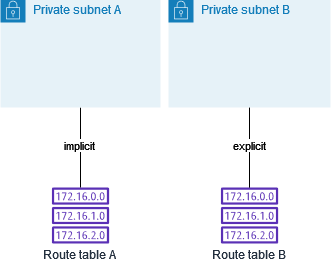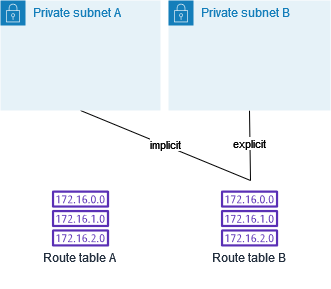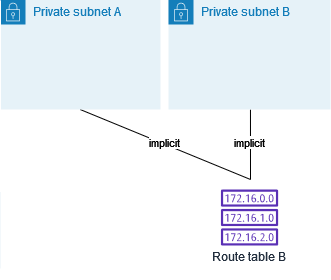Subnet route tables
Your VPC has an implicit router, and you use route tables to control where network traffic is directed. Each subnet in your VPC must be associated with a route table, which controls the routing for the subnet (subnet route table). You can explicitly associate a subnet with a particular route table. Otherwise, the subnet is implicitly associated with the main route table. A subnet can only be associated with one route table at a time, but you can associate multiple subnets with the same subnet route table.
Routes
Each route in a table specifies a destination and a target. For example, to enable
your subnet to access the internet through an internet gateway, add the following
route to your subnet route table. The destination for the route is 0.0.0.0/0,
which represents all IPv4 addresses. The target is the internet gateway that's attached
to your VPC.
| Destination | Target |
|---|---|
| 0.0.0.0/0 | igw-id |
CIDR blocks for IPv4 and IPv6 are treated separately. For example, a route with a
destination CIDR of 0.0.0.0/0 does not automatically include all IPv6
addresses. You must create a route with a destination CIDR of ::/0 for
all IPv6 addresses.
If you frequently reference the same set of CIDR blocks across your Amazon resources, you can create a customer-managed prefix list to group them together. You can then specify the prefix list as the destination in your route table entry.
Every route table contains a local route for communication within the VPC. This route is added by default to all route tables. If your VPC has more than one IPv4 CIDR block, your route tables contain a local route for each IPv4 CIDR block. If you've associated an IPv6 CIDR block with your VPC, your route tables contain a local route for the IPv6 CIDR block. You can replace or restore the target of each local route as needed.
Rules and considerations
-
You can add a route to your route tables that is more specific than the local route. The destination must match the entire IPv4 or IPv6 CIDR block of a subnet in your VPC. The target must be a NAT gateway, network interface, or Gateway Load Balancer endpoint.
-
If your route table has multiple routes, we use the most specific route that matches the traffic (longest prefix match) to determine how to route the traffic.
-
You can't add routes to IPv4 addresses that are an exact match or a subset of the following range: 169.254.168.0/22. This range is within the link-local address space and is reserved for use by Amazon services. For example, Amazon EC2 uses addresses in this range for services that are accessible only from EC2 instances, such as the Instance Metadata Service (IMDS) and the Amazon DNS server. You can use a CIDR block that is larger than but overlaps 169.254.168.0/22, but packets destined for addresses in 169.254.168.0/22 will not be forwarded.
-
You can't add routes to IPv6 addresses that are an exact match or a subset of the following range: fd00:ec2::/32. This range is within the unique local address (ULA) space and is reserved for use by Amazon services. For example, Amazon EC2 uses addresses in this range for services that are accessible only from EC2 instances, such as the Instance Metadata Service (IMDS) and the Amazon DNS server. You can use a CIDR block that is larger than but overlaps fd00:ec2::/32, but packets destined for addresses in fd00:ec2::/32 will not be forwarded.
-
You can add middlebox appliances to the routing paths for your VPC. For more information, see Routing for a middlebox appliance.
Example
In the following example, suppose that the VPC has both an IPv4 CIDR block and an IPv6 CIDR block. IPv4 and IPv6 traffic are treated separately, as shown in the following route table.
| Destination | Target |
|---|---|
| 10.0.0.0/16 | Local |
| 2001:db8:1234:1a00::/56 | Local |
| 172.31.0.0/16 | pcx-11223344556677889 |
| 0.0.0.0/0 | igw-12345678901234567 |
| ::/0 | eigw-aabbccddee1122334 |
-
IPv4 traffic to be routed within the VPC (10.0.0.0/16) is covered by the Local route.
-
IPv6 traffic to be routed within the VPC (2001:db8:1234:1a00::/56) is covered by the Local route.
-
The route for 172.31.0.0/16 sends traffic to a peering connection.
-
The route for all IPv4 traffic (0.0.0.0/0) sends traffic to an internet gateway. Therefore, all IPv4 traffic, except for traffic within the VPC and to the peering connection, is routed to the internet gateway.
-
The route for all IPv6 traffic (::/0) sends traffic to an egress-only internet gateway. Therefore, all IPv6 traffic, except for traffic within the VPC, is routed to the egress-only internet gateway.
Main route table
When you create a VPC, it automatically has a main route table. When a subnet does not have an explicit routing table associated with it, the main routing table is used by default. On the Route tables page in the Amazon VPC console, you can view the main route table for a VPC by looking for Yes in the Main column.
By default, when you create a nondefault VPC, the main route table contains only a local route. If you Create a VPC and choose a NAT gateway, Amazon VPC automatically adds routes to the main route table for the gateways.
The following rules apply to the main route table:
-
You can add, remove, and modify routes in the main route table.
-
You can't delete the main route table.
-
You can't set a gateway route table as the main route table.
-
You can replace the main route table by associating a custom route table with a subnet.
-
You can explicitly associate a subnet with the main route table, even if it's already implicitly associated.
You might want to do that if you change which table is the main route table. When you change which table is the main route table, it also changes the default for additional new subnets, or for any subnets that are not explicitly associated with any other route table. For more information, see Replace the main route table.
Custom route tables
By default, a route table contains a local route for communication within the VPC. If you Create a VPC and choose a public subnet, Amazon VPC creates a custom route table and adds a route that points to the internet gateway. One way to protect your VPC is to leave the main route table in its original default state. Then, explicitly associate each new subnet that you create with one of the custom route tables you've created. This ensures that you explicitly control how each subnet routes traffic.
You can add, remove, and modify routes in a custom route table. You can delete a custom route table only if it has no associations.
Subnet route table association
Each subnet in your VPC must be associated with a route table. A subnet can be explicitly associated with custom route table, or implicitly or explicitly associated with the main route table. For more information about viewing your subnet and route table associations, see Determine the explicit associations.
Subnets that are in VPCs associated with Outposts can have an additional target type of a local gateway. This is the only routing difference from non-Outposts subnets.
Example 1: Implicit and explicit subnet association
The following diagram shows the routing for a VPC with an internet gateway, a virtual private gateway, a public subnet, and a VPN-only subnet.

Route table A is a custom route table that is explicitly associated with the public subnet. It has a route that sends all traffic to the internet gateway, which is what makes the subnet a public subnet.
| Destination | Target |
|---|---|
VPC CIDR |
Local |
| 0.0.0.0/0 | igw-id |
Route table B is the main route table. It is implicitly associated with the private subnet. It has a route that sends all traffic to the virtual private gateway, but no route to the internet gateway, which is what makes the subnet a VPN-only subnet. If you create another subnet in this VPC and don't associate a custom route table, the subnet will also be implicitly associated with this route table because it is the main route table.
| Destination | Target |
|---|---|
VPC CIDR |
Local |
| 0.0.0.0/0 | vgw-id |
Example 2: Replacing the main route table
You might want to make changes to the main route table. To avoid any disruption to your traffic, we recommend that you first test the route changes using a custom route table. After you're satisfied with the testing, you can replace the main route table with the new custom table.
The following diagram shows two subnets and two route tables. Subnet A is implicitly associated with route table A, the main route table. Subnet B is implicitly associated with route table A. Route table B, a custom route table, isn't associated with either subnet.

To replace the main route table, start by creating an explicit association between subnet B and route table B. Test route table B.

After you've tested route table B, make it the main route table. Subnet B still has an explicit association with route table B. However, subnet A now has an implicit association with route table B, because route table B is the new main route table. Route table A is no longer associated with either subnet.

(Optional) If you disassociate subnet B from route table B, there is still an implicit association between subnet B and route table B. If you no longer need route table A, you can delete it.
